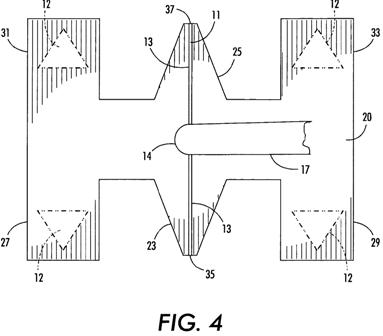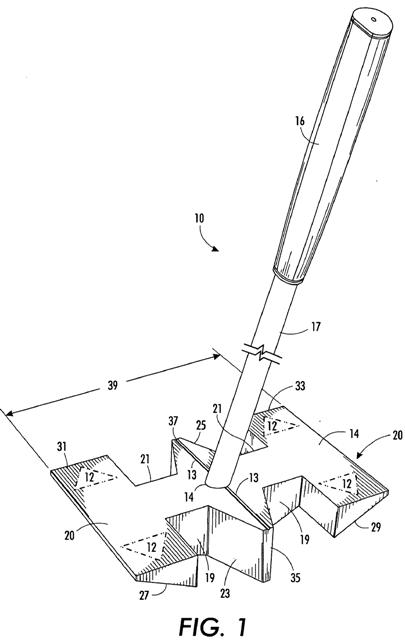Yep, If You Can Putt with this Practice Putter Invention Then You Are Probably a Darn Good Putter
I can’t imagine how a golfer can dispute that practicing with this putter will make you a better putter, although it would probably be very humbling and frustrating. This practice putter is disclosed in a patent application that published as US Pub. No. 20090227387 titled “Practice Putter with Pointed Striking Surface.”
The application explains:
[0012] It is one of the objectives of this invention to provide a practice putter head which will enable the practicer to establish the position in which the practice putter head should be held to hit the ball along the desired path to the golf hole.
[0013] It is another objective of the invention to provide a practice putter head which will, due to its V shaped pointed striking surface, provide immediate feedback as to whether the V shaped point striking surface struck the ball in the middle of the golf ball and if the practice putter head remained at the desired angle from set up, to pull back stroke, through hitting the ball, and throughout the follow through. If it is not done properly, the ball will immediately move in the direction of the side of the V shaped point that is wrongly struck. As in all learning, immediate feedback is imperative; and this practice putter head provides such immediate feedback as to allow the practicer to make necessary adjustments right away.
[0014] It is yet another objective of this invention to provide, through the V shaped striking point, a means of determining a portion of the path along which the golf ball is intended to follow in order to roll into the golf hole.
[0015] Yet another objective of the invention is to provide the player with a means of developing what is known as “muscle memory”, meaning with consistent and successful practice, the muscles in the arms, wrists, and hands will “remember” the feeling of the appropriate pull back stroke, striking position of the putter, and the follow through stroke.
[0016] Yet another objective of this invention is to provide a practice putter that is simple in design, economical to produce, effective for both indoor and outdoor practice, equally effective for any age/sex golfer, equally effective for both right and left handed golfers, and pleasing to the eye.
[0017] There have been many putting training aids on the market. None have focused almost entirely on developing “muscle memory” in the hands, wrists, and arms without the assistance of some type of rail system used to guide the putter. One of the primary reasons golfers miss putts is that in the midst of pulling the putter head back in preparation for the fore stroke, the putter face turns and does not remain straight, causing the ball to roll in a direction different than intended when the golfer initially lined up the putt. The V shaped point used as the striking surface of the practice putter head invention serves as a visual aid in assuring the putter point continues to point in the desired direction during back stroke, fore stroke, and follow through. It also serves as an immediate source of feedback. If the putter head face does not remain straight during back stroke, fore stroke, and follow through, the point of the V will not strike the ball in the center and the ball will immediately roll in the direction the putter head’s V shaped point was pointing upon impact. The golfer will know exactly what corrective action must be taken to correct the error in their putting stroke.
[0018] FIG. 1 is a partial perspective view of a practice putter 10 comprised of a shaft 17 connected to a putter head 20. As will be apparent, the shaft 17 is not drawn to scale and is substantially longer than indicated in the Figure.
[0019] In the embodiment depicted in FIG. 1, the shaft is attached to a grip 16. This grip 16 can be made of rubber, leather, neoprene, or any other standard golf putter grip material. The size of the grip can be standard golf club grip size, oversized for people who prefer a larger grip feel in their hands. The shape of this grip can be round, or flat on the front of the grip where the golfer normally places his/her thumbs. The length of the grip is approximately 10 inches (in one embodiment), but it can be other lengths.
[0020] Referring again to FIG. 1, the putter head 20 may be any shape that putter heads conventionally have, including rectangular, square, half-moon, blade, and other shapes. In general, the putter heads conventionally have a front side and back side. Putter head 20 has such a front side 19 (corresponding to its “right side”), and a back side 21 (corresponding to its “left side”).
[0021] Extending from front side 19 is a first substantially V-shaped assembly 23. Extending from back side 21 is a second substantially V-shaped assembly 25. These V-shaped assemblies provide the striking surfaces used in applicant’s practice putter; and they will be described in greater detail elsewhere in this specification.
[0022] Referring again to FIG. 1, also extending from front side 19 are wings 27 and 29. Extending from back side 21 are wings 31 and 33. Such wings 27, 29, 31, and 33 may be the same or different. In one embodiment, they have substantially the same weight, substantially the same size, and substantially the same shape. Without wishing to be bound by any particular theory, applicant believes that these wings provide a balanced feel to his practice putter.
[0023] Referring again to FIG. 1, the putter shaft 17 is preferably cylindrical in shape and can vary in length from the standard putter shaft length to any length desired by the golfer. The standard diameter of the shaft is preferably 0.370 inches, but can be larger or smaller. The shaft can be made of steel, graphite, aluminum, wood, fiberglass, or any combination of materials. The shaft can be “stepless”, “double bend”, “straight” or other variations of the above mentioned types. The shaft 17 is present to assist the golfer in moving the practice putter head in the desired direction and with the desired speed as to propel the golf ball in the direction of the golf hole. In the embodiment depicted, the shaft 17 is preferably anchored into the putter head 20 by being affixed into a pre-placed hole (not shown) on the top surface of the practice putter head 20. The material used to affix the shaft 17 into the hole (not shown) can be any type of glue, epoxy, or other bonding material.
[0024] The practice putter head 20 can be made of metal, wood, fiberglass, or any combination of materials desired.
[0025] Referring again to FIG. 1, and in the preferred embodiment depicted, the top surface 14 of putter head 20 is comprised of an alignment line 13 that preferably extends from the first substantially V-shaped assembly 23 to the second substantially V-shaped assembly 25, and also from striking surface 35 to striking surface 37. The alignment line 13 is preferably a slot 13 that is cut into the surface 14 to a depth of from about 0.02 to about 0.20 inches. The alignment line 13 assists the golfer in aligning the putter head 20 with the golf ball (not shown).
[0026] The substantially V-shaped assemblies 23 and 25 can provide different striking surfaces 35 and 37. In the embodiment illustrated in FIG. 1, striking surfaces 35 and 37 are substantially flat. In another embodiment, not shown, striking surfaces 35 and 37 are arcuate. In another embodiment, not shown, striking surfaces 35 and 37 present sharp V-shaped points. The term “substantially V-shaped assembly” is meant to comprehend each of these (and other) assemblies with each of these (and other) striking surfaces. Similarly, the term “pointed” refers to striking surfaces that may be flat, arcuate, or sharply V-shaped.
[0027] Referring again to FIG. 1, it will be apparent that practice putter 10 can advantageously be used by both right-handed and left-handed golfers. Whether a golfer using the putter is left or right handed, the surfaces 35 and 37 are substantially the same. The alignment line 13 extends from one striking surface 35 to another striking surface 37 to assist in aligning either of such striking surfaces with a golf ball. The triangular designs 12 on each corner of the head 20 are used to assist with direction. In one embodiment, the length 39 of the putter head 20 is about 4 inches.
Nice invention, but I would rather have a removable attachment for the face of my everyday putter.
Dave Dawsey – Watching Golf Putter Inventions
PS – check out additional putter patents HERE


